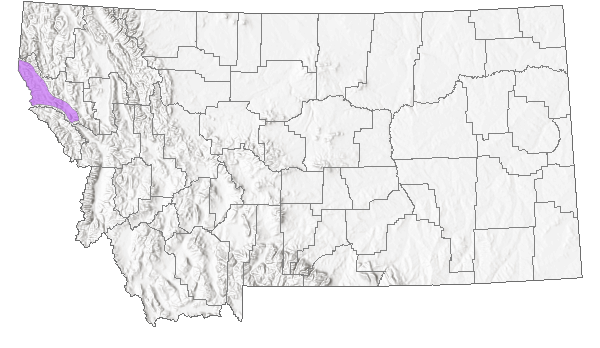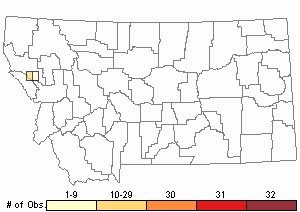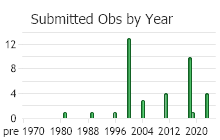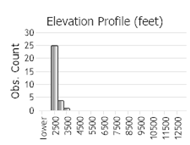View in other NatureServe Network Field Guides
NatureServe
Montana
Utah
Wyoming
Idaho
Wisconsin
British Columbia
South Carolina
Yukon
California
New York
Sand Springbeauty - Claytonia arenicola
Other Names:
Montia arenicola
State Rank Reason (see State Rank above)
Rare in Montana, where it is currently known from only one localized area in the western portion of the state. As an annual, populations likely fluctuate widely from year to year. No specific threats have been identified.
- Details on Status Ranking and Review
Population Size
Score1-2 - Small to Moderate. Population size is imprecisely known but is believed to be >2,000 individuals and <100,000 individuals.
Range Extent
Score3 - Local Endemic or Very Small Montana Range: Generally restricted to an area <10,000 sq. miles (equivalent to the combined area of Phillips and Valley Counties) or <6 Sub-basins (4th code watersheds) Range-wide OR limited to one Sub-basin in Montana
Area of Occupancy
Score3 - Very Low: Generally occurring in 3 or fewer Subwatersheds (6th Code HUC’s).
Environmental Specificity
Score1 - Moderate: Species is restricted to a specific habitat that is more widely distributed or to several restricted habitats and is typically dependent upon relatively unaltered, good-quality habitat (C Values of 5-7).
Trends
ScoreNA - Rank factor not assessed.
CommentTrends unknown, though populations are likely stable or experiencing only minor declines. Habitat generally appears to be stable.
Threats
Score0-1 - Low to Medium.
Intrinsic Vulnerability
Score1 - Moderate Vulnerability: Specific biological attributes, unusual life history characteristics or limited reproductive potential makes the species susceptible to extirpation from stochastic events or other adverse impacts to its habitat and slow to recover.
Raw Conservation Status Score
Score
9 to 11 total points scored out of a possible 16 (Rarity factors and threats only).
General Description
Sand Springbeauty is an annual with usually several lax to erect 5-15 cm long stems which arise from a slender taproot. The linear to narrowly spatulate leaves are 15-60 mm long and occur in a basal rosette; they are opposite on the lower stem. Foliage is glabrous. Several well-separated flowers are borne on spreading stalks that are up to 2 cm long and located at the top of the stem. Each flower has 5 pink-veined, white petals, that are 6-9 mm long; each flower also has 2 sepals that are ca. 2 mm long and 5 stamens. The single pistil has a globose ovary with 6 ovules. The fruit is a 3-valved capsule that is approximately as long as the sepals. The capsule produces 1-6 seeds that are black, rounded, shiny, and smooth.
Sources: Miller in Flora of North America 2003; Lesica et al. 2012.
Phenology
Flowering in May.
Diagnostic Characteristics
Potentially confused with Montia dichotoma and M. linearis but these have alternate, linear leaves.
Species Range
Montana Range
Range Descriptions

 Native
Native
Range Comments
In MT only known from Sanders County; a regional endemic from eastern WA, OR and adjacent ID (Lesica et al. 2012. Manual of Montana Vascular Plants. BRIT Press. Fort Worth, TX).
Observations in Montana Natural Heritage Program Database
Number of Observations: 38
(Click on the following maps and charts to see full sized version)
Map Help and Descriptions
Relative Density

Recency



 (Observations spanning multiple months or years are excluded from time charts)
(Observations spanning multiple months or years are excluded from time charts)
Habitat
Mossy, forested, north-facing talus slopes in the lower montane zone.
National Vegetation Classification System Groups Associated with this Species
Forest and Woodland
Low Elevation - Xeric Forest and Woodland
Montane - Subalpine Forest and Woodland
Sparse and Barren
Sparse and Barren
Ecology
POLLINATORS The following animal species have been reported as pollinators of this plant species or its genus where their geographic ranges overlap:
Bombus vagans,
Bombus ternarius,
Bombus pensylvanicus, and
Bombus impatiens (Colla and Dumesh 2010, Williams et al. 2014).
Stewardship Responsibility
Threats or Limiting Factors
STATE THREAT SCORE REASON
Threat impact not assigned because threats are not known (MTNHP Threat Assessment 2021).
References
- Literature Cited AboveLegend:
 View Online Publication
View Online Publication Colla, S.R. and S. Dumesh. 2010. The bumble bees of southern Ontario: notes on natural history and distribution. Journal of the Entomological Society of Ontario 141:39-68.
Colla, S.R. and S. Dumesh. 2010. The bumble bees of southern Ontario: notes on natural history and distribution. Journal of the Entomological Society of Ontario 141:39-68. Flora of North America Editorial Committee. 2003. Flora of North America North of Mexico, Volume 4, Magnoliophyta: Caryophyllidae, Part 1. Oxford University Press, New York. 584 p.
Flora of North America Editorial Committee. 2003. Flora of North America North of Mexico, Volume 4, Magnoliophyta: Caryophyllidae, Part 1. Oxford University Press, New York. 584 p. Lesica, P., M.T. Lavin, and P.F. Stickney. 2012. Manual of Montana Vascular Plants. Fort Worth, TX: BRIT Press. viii + 771 p.
Lesica, P., M.T. Lavin, and P.F. Stickney. 2012. Manual of Montana Vascular Plants. Fort Worth, TX: BRIT Press. viii + 771 p. MTNHP Threat Assessment. 2021. State Threat Score Assignment and Assessment of Reported Threats from 2006 to 2021 for State-listed Vascular Plants. Botany Program, Montana Natural Heritage Program, Helena, Montana.
MTNHP Threat Assessment. 2021. State Threat Score Assignment and Assessment of Reported Threats from 2006 to 2021 for State-listed Vascular Plants. Botany Program, Montana Natural Heritage Program, Helena, Montana. Williams, P., R. Thorp, L. Richardson, and S. Colla. 2014. Bumble Bees of North America. Princeton, NJ: Princeton University Press. 208 p.
Williams, P., R. Thorp, L. Richardson, and S. Colla. 2014. Bumble Bees of North America. Princeton, NJ: Princeton University Press. 208 p.
- Additional ReferencesLegend:
 View Online Publication
View Online Publication
Do you know of a citation we're missing? Lesica, P., M.T. Lavin, and P.F. Stickney. 2022. Manual of Montana Vascular Plants, Second Edition. Fort Worth, TX: BRIT Press. viii + 779 p.
Lesica, P., M.T. Lavin, and P.F. Stickney. 2022. Manual of Montana Vascular Plants, Second Edition. Fort Worth, TX: BRIT Press. viii + 779 p.
- Web Search Engines for Articles on "Sand Springbeauty"





